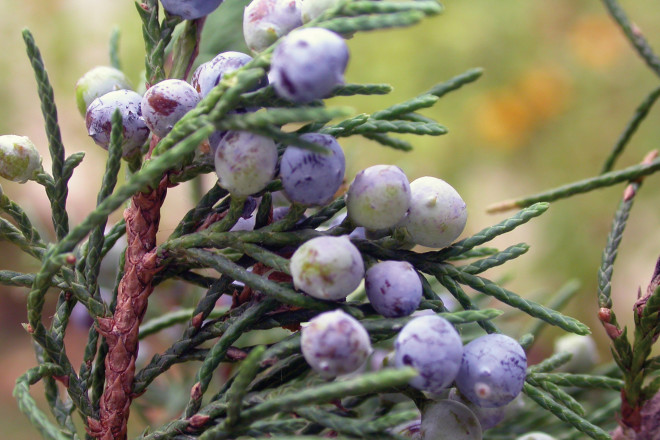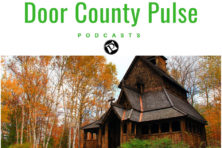Juniper
- Share
- Tweet
- Pin
- Share

Few people would sense a relationship between a species of juniper and the old-fashioned “two for a nickel” lead pencils, nor would they realize the importance of that same plant to Baton Rouge, Louisiana.
The light aromatic wood, used in the manufacture of pencils for many years, was derived from the Eastern Redcedar, Juniperus virginiana. Baton Rouge, named by French Canadians, means red stick in reference to the many redcedar trees native to that region. It is spelled as one word because it is not a true cedar.
It was John Muir, famous Wisconsin naturalist and one of my idols, who, in a roundabout way, aroused my interest in this famous widely distributed tree. Muir set out on foot in the fall of 1867 from Jeffersonville, in northern Kentucky, for Cedar Key located along the northeastern gulf coast of Florida. While there he worked briefly in a large redcedar mill, a part of one of the pencil factories in operation there. The Eberhard-Faber and Eagle pencil companies maintained large plants there for many years until the supply of redcedar trees, originally thought to be “inexhaustible,” was depleted.
The Eastern Redcedar received its first scientific interest when botanical specimens were collected in the Virginia colony. Early settlers realized, as they moved westward, that this important tree grew throughout much of the eastern half of the U.S. to the Great Plains. Many pioneers, fresh from the city, quickly learned that this soft wood could be easily fashioned into a durable log house and that the wood was excellent for starting fires.
Even though it is a true juniper, it undoubtedly owes its cedar nickname to those early settlers who came from the Mediterranean region where the somewhat similar true cedars were plentiful. Redcedars prefer abandoned fields, gravelly slopes or glacial moraines, mineral soil, dryish sites, limestone outcroppings, and do especially well on south slopes or in open sunlight. Locate a site possessing these characteristics and you’ll very likely find redcedars growing there.
Magnificent redcedar glades, pure stands of them, can be found in the hilly western part of Dane County. Another of my favorite sites in which to observe them is on the high flat-topped rocky cliffs in the Red Banks area, south of Dyckesville, along Highway 57. They grow there intermingled with Northern White Cedar, Thuja occidentalis, another lover of limey soil.
Redcedars are extremely sensitive to fire. I have often wondered whether this comparatively dry site, high above the waters of Green Bay, escaped the Peshtigo Fire of 1871 which burned its way into northeastern Brown County and southern Door County.
Orchardists, especially those who grow apples, have for years been opposed to the introduction of redcedars into their region. Their main objection to its use is that it may be a bridging or alternate host for rust, referred to as the Cedar-apple Rust, wh ich is known to attack various trees, especially apples. A large-scale move by easterners to destroy redcedar trees years ago led to a favorite slogan, “Cedar or Cider!”
ich is known to attack various trees, especially apples. A large-scale move by easterners to destroy redcedar trees years ago led to a favorite slogan, “Cedar or Cider!”
Juniper is a genus in the cedar or cypress family, Cupressaceae. Juniperus comes from the Latin meaning “forever young.” There are more than 60 species in the northern hemisphere. A very abundant plant in Door County grows mainly as a large shrub. It is the Common Juniper, Juniperus communis. Its spiny, awl-like needles are quite uncomfortable to brush against while walking in a field covered with these plants. It can also grow in a woodland setting but prefers the sunny meadows. When you drive south on County Road A from Highway 42 you will see many of the Common Junipers in the higher sunny openings. It thrives on rocky soils. The Common Juniper is the source of the berries (technically the cones) that are used to give gin its distinctive flavor.
Young berry-like cones are green at first but turn to a frosty dark blue or purplish-brown by autumn. Several birds are very fond of the fleshy pulp, especially the Cedar Waxwing that was in fact named in honor of this fine tree. Evening Grosbeaks, Purple Finches, robins, Yellow-bellied Sapsuckers, bluebirds and even Tree Swallows consume the berries. The flesh of the berries is digested while the seeds pass through their digestive systems undamaged to be planted far and wide, particularly along roadways and fencerows where the birds have perched.
Another less conspicuous member of this genus is the Horizontal Juniper, Juniperus horizontalis, which can be found growing in sandy areas like The Ridges Sanctuary in Baileys Harbor. It has needles that are more “cedar-like” and gentle to the touch. It also has cones or berries like the Common Juniper. This plant is true to its name, never getting very tall but spreading easily, making it a good ground cover. It is native to much of northern North America.
A distant cousin to the redcedar, the Incense Cedar, Calocedrus decurrens, has become the “Pencil Cedar” of the 20th century. Apparently better use is being made of this western tree through modern technology than with the gigantic four-foot-wide redcedars of the olden days when as much as 90 percent of each tree was wasted due to a few knots.
I have fond memories as a child in grade school, of cleaning out the pencil sharpeners and relishing the wonderful “perfume” of the redcedar wood of which the pencils were made.
As much as I desire to plant some redcedars on our land, I would much sooner honor the apple growers nearby. I will be content to admire these “pencil trees” with a tip of my hat to John Muir, in their native environments, Red Banks in eastern Wisconsin, Dane County or Cedar Key, Florida.
Photography by Roy Lukes.


